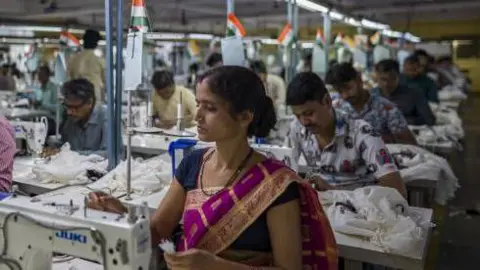The UK and India have recently formalized a significant trade agreement aimed at streamlining the exchange of goods and services between the two nations. This landmark deal is heralded by the British government as the “most economically significant” agreement reached following the UK’s departure from the European Union in 2020. The anticipation is that this arrangement will bolster the economies of both countries by facilitating easier and cheaper transactions.
Set against a backdrop of extensive negotiations lasting approximately three years, this trade accord promises to make a marked impact on various sectors. In essence, the agreement is designed to enhance economic cooperation by lowering tariffs and increasing market access for goods. For instance, the UK has reduced taxes on an array of imports from India, including clothing, footwear, food products—particularly frozen prawns—and jewellery. In return, India has lowered tariffs on several UK exports, such as cosmetics, scotch whisky, and automobiles, as well as on food items like lamb and salmon.
With specific sectors in mind, the deal suggests great potential for transforming British businesses, particularly those involved in manufacturing. The reduction in tariffs on goods such as whisky and cars could enable UK firms to capitalize on opportunities to sell in the Indian market, which is characterized by a burgeoning middle class with increasing purchasing power. For instance, the tariff on whisky imports into India will drop substantially from 150% to 75%, eventually tapering down to 40% over the duration of the agreement. Likewise, automobile tariffs are poised to decrease dramatically from over 100% to 10%.
However, while the deal presents a positive outlook, it is essential to note that its effects will not be immediately felt; the agreement is set to take effect in approximately a year. Over time, consumers in both countries might start to experience benefits such as lower prices and a broader selection of products. In the UK, reduced tariffs on textiles and food may offer consumers cheaper and more diverse shopping options. On the other side, Indian consumers could access a wider variety of goods from the UK, thanks to more competitive pricing in sectors like cosmetics and specialty foods.
From a strategic standpoint, this trade agreement holds considerable importance for the UK and India alike. It is the UK’s third largest trade agreement after those established with Australia and Japan, underscoring the importance of the Indian market within the UK’s broader trade strategy, especially as the UK looks to establish itself in the post-Brexit landscape. Additionally, trade between the UK and India reached £41 billion last year, and the UK government projects that the new deal may enhance that figure by an additional £25.5 billion annually by the year 2040.
While the deal addresses economic aspects, it also touches on immigration issues, which have been a sticking point in negotiations. India sought concessions regarding visa regulations for its professionals and students. However, the current trade deal does not alter the existing immigration policies, although it includes provisions affecting social security contributions for Indian employees in the UK on short-term visas.
The agreement stipulates a three-year exemption from social security for Indian workers in the UK, which reflects India’s insistence during talks to avoid dual contributions. Business Secretary Jonathan Reynolds emphasized that the deal would allow for streamlined opportunities for skilled workers from India to engage in temporary employment in the UK.
Ultimately, the UK-India trade agreement represents a critical step toward deepening bilateral relations while promising significant economic benefits for both nations. As global dynamics shift, particularly with the rise of India as a future economic powerhouse, this deal is integral for the UK to foster trade relationships outside of its traditional partnerships, particularly with the European Union. Both countries now stand at a pivotal point where this partnership could lead to enhanced economic growth and cooperation in the years to come.



